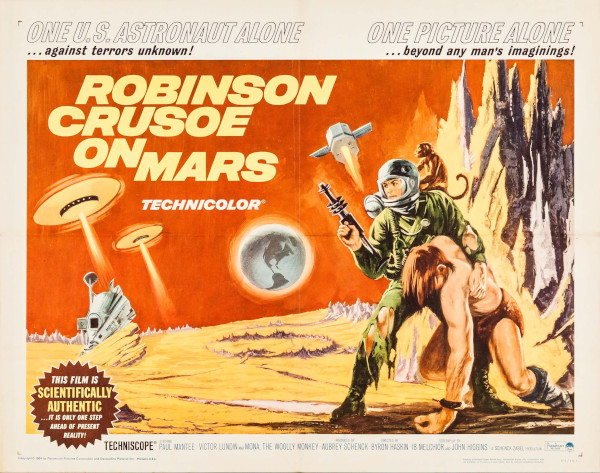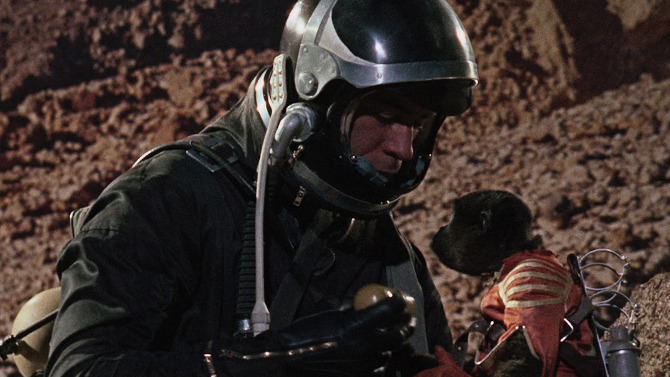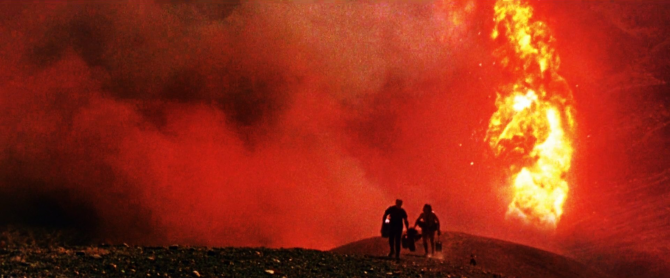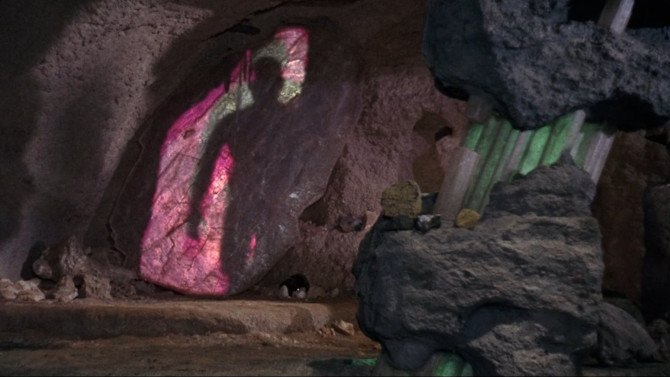An intriguing reworking of Daniel Defoe’s classic 1719 novel “Robinson Crusoe”, director Byron Haskin, who in 1953 brought aliens from Mars to Earth with the epic The War of the Worlds, this time flips the script and takes us to the red planet with the sci-fi cult classic Robinson Crusoe on Mars (1964).
Though falling comfortably within the sci-fi genre, Paramount’s promotional team clearly reveled in the movie’s attempted accuracy – the trailer and advertising posters reading: “This film is scientifically authentic. It is only one step ahead of present reality”. And, in many ways, it was impressively accurate for what was known at that moment. Released at the perfect time in history, 1964 was just one year prior to the first spacecraft fly by of Mars. . . before that, all that we knew was by way of observation through telescope. What would be found was much less promising than expected – hope that there were canals of water and enough oxygen to breathe for a couple of minutes without aid were dashed just a year later. . . but this 1964 vision is what astronomers, scientists, and dreamers hoped Mars to be.
Following the first manned mission to the red planet, the small crew consists of Cmdr. Christopher Draper (Paul Mantee) and Col. Dan McReady (Adam West – two years prior to his most iconic role as tv’s Batman). . . as well as their helpful monkey Mona (The Woolly Monkey).
Unluckily, they find themselves on an unexpected collision course with a meteoroid. . . they are forced to burn the rest of their fuel to avoid contact. Descending separately on their lifeboat pods, they are separated, leaving Draper stranded from his mate on this inhospitable planet – one inaccurate detail finds fire frequently burning in certain locations. . . while random fireballs can come zooming by from time to time. After finding Mona hidden in the wreckage, he then turns his attention to figuring out how to survive with limited oxygen tanks, no heat source, a few tubes of food, and the solitude of what seems like an uninhabited Mars.
Filmed in the equally inhospitable Death Valley, California, the locale quite accurately depicts what we’ve seen of the red planet’s surface. . . sandy dunes, craggy rock formations and mountains, as well as frigid polar icecaps. By way of luck and smarts, Draper figures out a way to extend his future. . . though that doesn’t make his isolation any easier.
As this is science fiction, he soon learns that some alien life form does visit the planet, mining it by way of slaves. A cool connection finds the alien crafts looking an awful lot like the weapons used by the Martians in The War of the Worlds. Draper is able to rescue one of the slaves, drawing the ire of the superior aliens. Calling him Friday (Victor Lundin) – like Crusoe’s companion in the novel, he attempts to teach him English and keep him alive as the aliens return to the planet every eight weeks to gather more of whatever resource they’re collecting.

The stunning original half sheet poster for Robinson Crusoe on Mars – which features the “SCIENTIFCALLY AUTHENTIC” stamp in the bottom left corner
A kitschy cool vision of Mars, the combination of fact and fiction makes it rather intriguing. Transforming from a battle of man versus nature into one of man versus technologically superior man, we get to see both the science and the fiction. Air pills are one thought provoking concept explored – don’t get too excited, M&Ms were actually used by the prop department. And, while we’re at it, the poi sausages discovered as a food source are simply pepperoni. Yet, these simple tricks are very effective, as are the impressive matte background paintings (including an eerily blood red sky), hand animation, miniatures, and other visual trickery. It is topped off with Technicolor and Techniscope majesty by cinematographer Winton H. Hoch (The Quiet Man; The Searchers) – aurora-like reds, purples, and greens bring an uncanny otherworldly essence to this astronaut’s new barren home.
Sadly, despite its amazing posters, Robinson Crusoe on Mars was poorly pushed by Paramount and floundered at the box office, putting an end to the already talked about sequel. Some also blamed the title for failing to draw interest. . . its original name was Gravity Probe One: Mars – though that was deemed too documentary-like. Nonetheless, over the decades, it has garnered a robust fan base that have fallen prey to its combination of space adventure, science fiction, and novel ingenuity. So, don’t monkey around, discover Mars like you’ve never seen it before, circa 1964.




